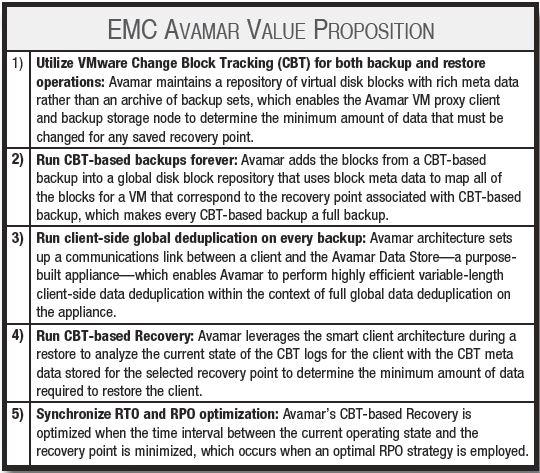Protecting The Software-Defined Data Center
Data centres are becoming more difficult to manage and protect as more data and applications are moved into virtual software-defined environments. Adding fuel to the fire, CIOs must now deal with corporate mandates to build an IT infrastructure that scales to unknown demand levels and provides service assurance for fluctuating conditions that cannot be accurately projected. To gain an insight into how EMC Avamar builds high efficiency and high performance into a unified data protection solution for physical and virtual systems, a series of backup and restore tests were run in a VMware® vSphere 5.1 environment. Tests were performed on EMC systems and the Avamar 6.1 results were compared to CommVault Simpana 9, and Symantec NetBackup 7.5.0.4.
For CIOs, the data protection equation is rapidly becoming further complicated by a growing trend among corporate departments to store “copy data” as an internal way to deal with their own needs for local data backup, and protection. Propelling the data copy problem is a toxic brew that is one part fear of government regulations and compliance mandates on how companies function and one part distrust of corporate IT to provide fast recovery services that never require the retrieval of tapes from an off-site location. As a result, there is a growing trend within Line of Business (LoB) groups to be over-protective with data by keeping multiple secondary copies.
Underscoring the seriousness of this problem, a recent IDC Insight Note on The Economics of Copy Data, found copy data was responsible for a major portion of enterprise data growth. Only 25% of added enterprise data was cited as being unique from a document perspective. From a block-data perspective, however, added data is likely to be less than 5% unique. What’s more, while IDC found that several copies were maintained for most files, it was not unusual for some files to have upwards of 100 copies.
For CIOs, the immediate challenge is to master this chaotic environment and deal with the explosive growth in the volume of data in an optimal manner. In the long run, they must also staunch the growth of copy data by providing centralized data protection procedures that LoB groups will accept and adopt as part of their own internal processes. CIOs are also expected to enter into highly visible Service Level Agreements (SLAs) with LoB executives with respect to maintaining business continuity. What’s more, success in assuaging the business continuity fears of LoB executives can help forge successful partnerships between IT and LOB organizations in dealing with the data-copy iceberg.
A growing majority of CIOs, are finding a solution to these issues in a transition to a private cloud paradigm characterized by a software-defined, hypervisor-based, Virtual Infrastructure (VI). While a VI provides the technology to optimize physical server resources, it also introduces new data protection paradigms that can introduce greater complexity and make operations far less efficient when virtual and physical machines need separate backup methods and procedures. For CIOs confronted with the VI data- protection conundrum, EMC’s Avamar presents IT administrators with a smart unified solution that applies to physical and virtual machines in a way that is perfectly aligned with the explosive data copy issue.
Application Specific Plug-Ins
To provide IT administrators, with sophisticated backup and recovery options, EMC’s Avamar leverages platform-specific agents for a wide array of business-critical applications across numerous operating systems running on client machines. The Avamar agents communicate with the Avamar Data Store and utilize multiple software plugins to provide specific features for file systems and business-critical applications.
Through this plugin-centric smart client architecture, data deduplication is enabled at any client to reduce both the amount of data transmitted to the Avamar Data Store and the amount of data stored. More importantly, this highly efficient client-side data deduplication procedure is performed globally across all virtual machines and physical machines.
During a backup, the Avamar agent breaks the client system’s files into variable-length segments in order to identify redundant data and tag a single instance of the data with a unique ID. Next, the agent contacts the Avamar Data Store to determine if the single instance ID is already stored. If the unique ID is not present on the Avamar Data Store the agent compresses and sends the new segment to be cataloged with a the new segment ID. Otherwise, only a link to the existing ID is sent for every instance of the segment.





